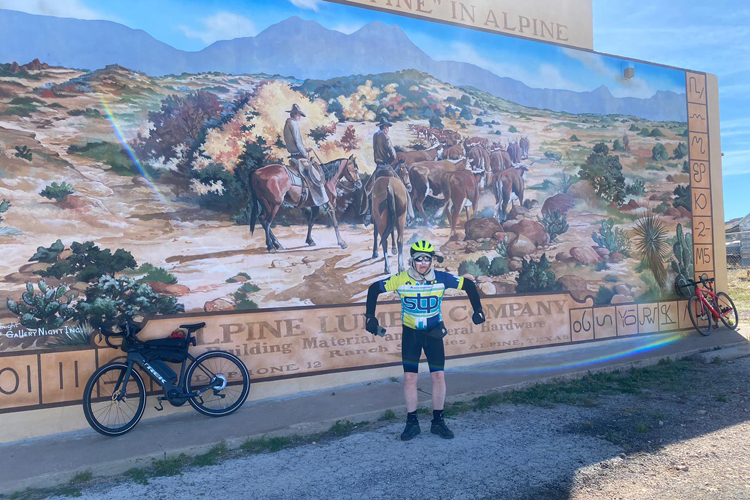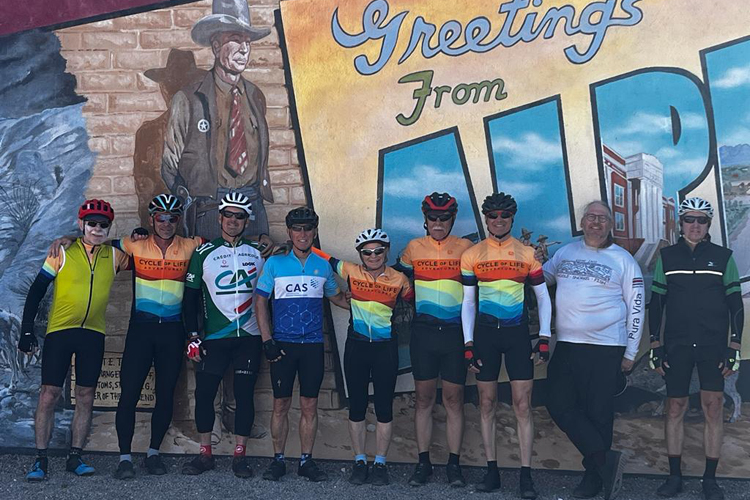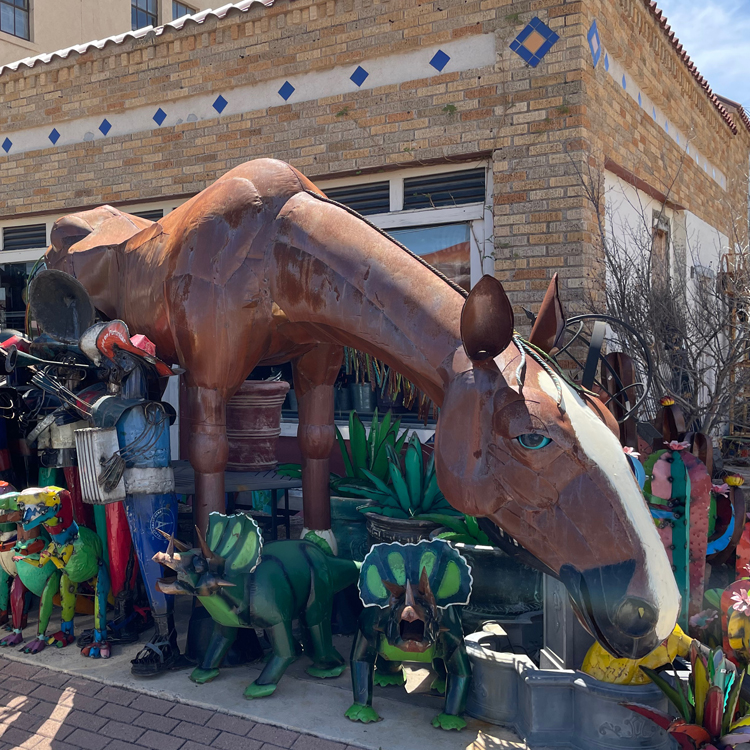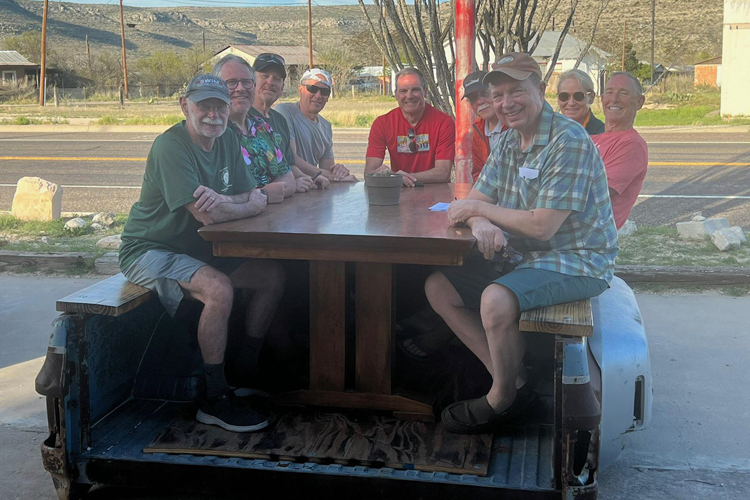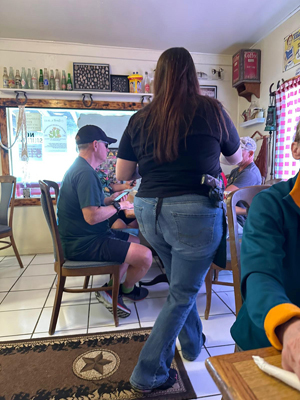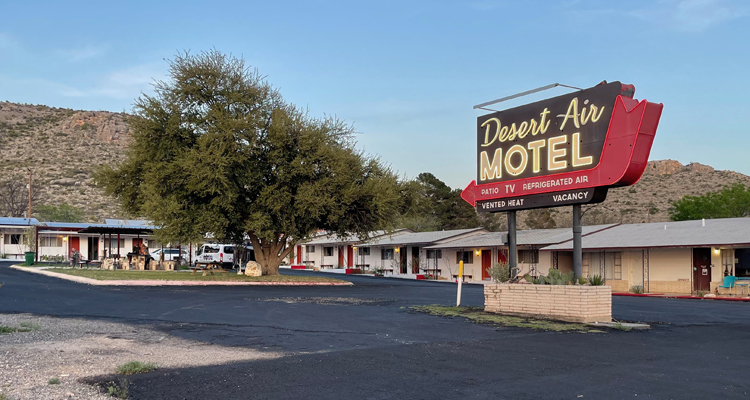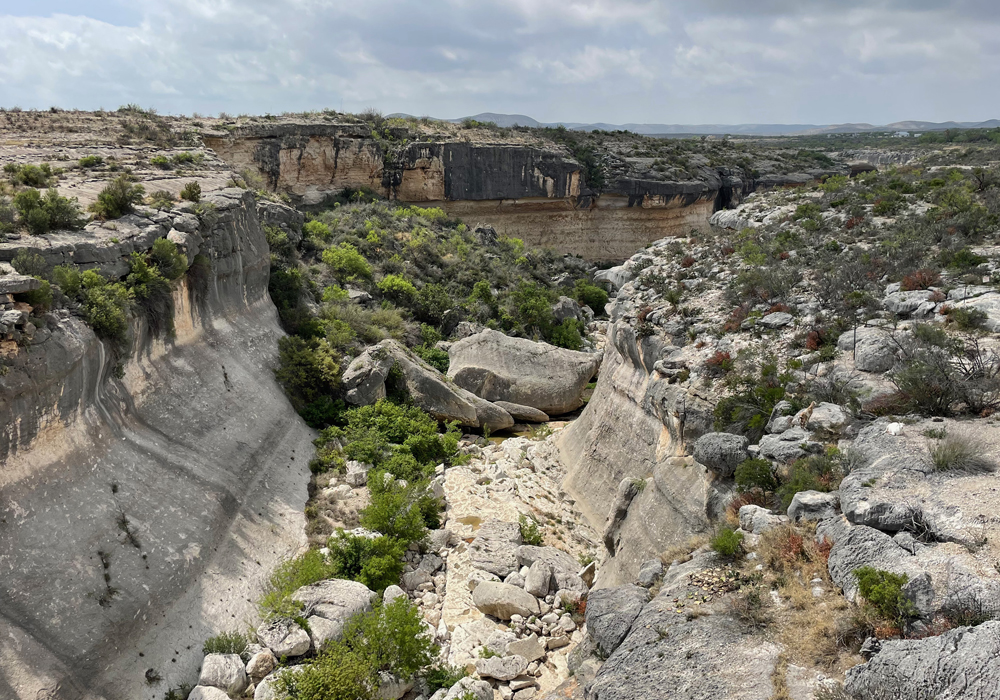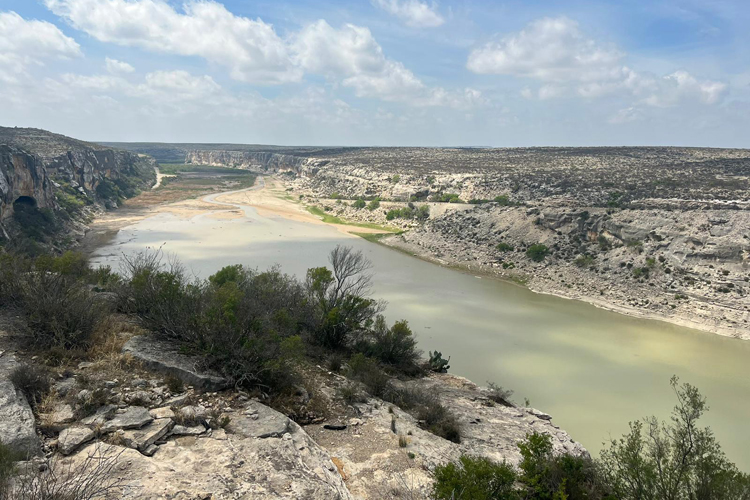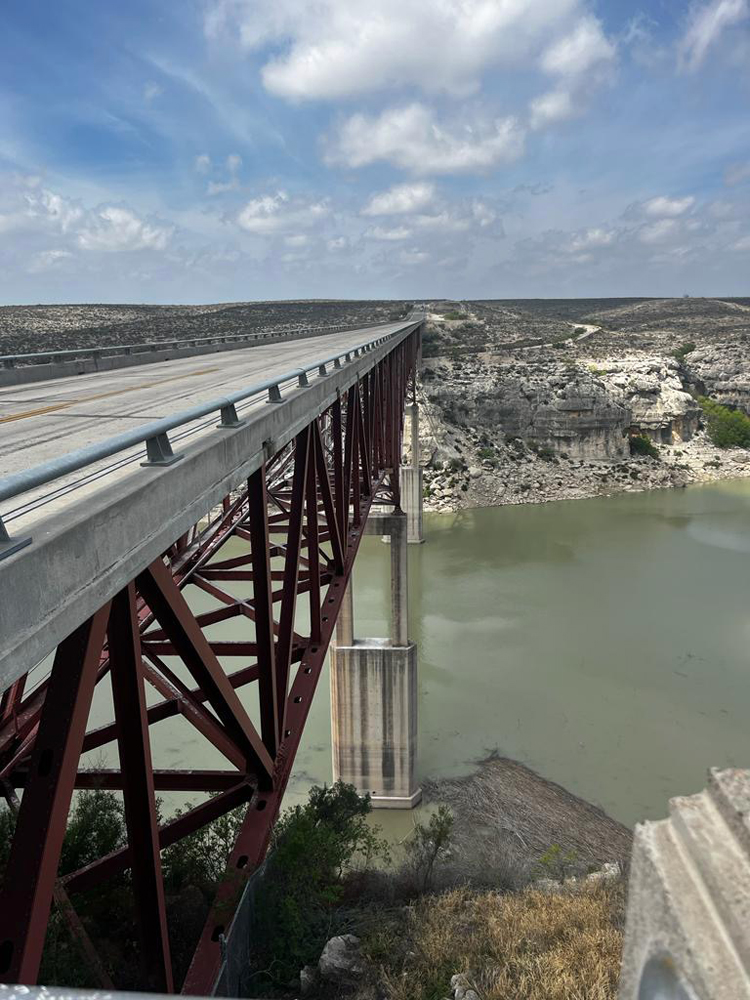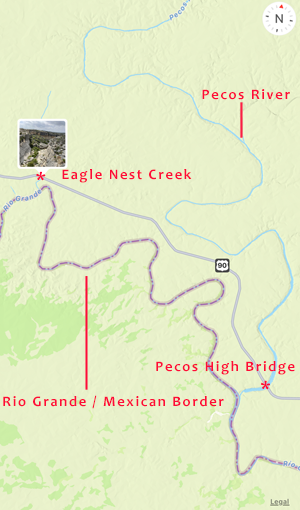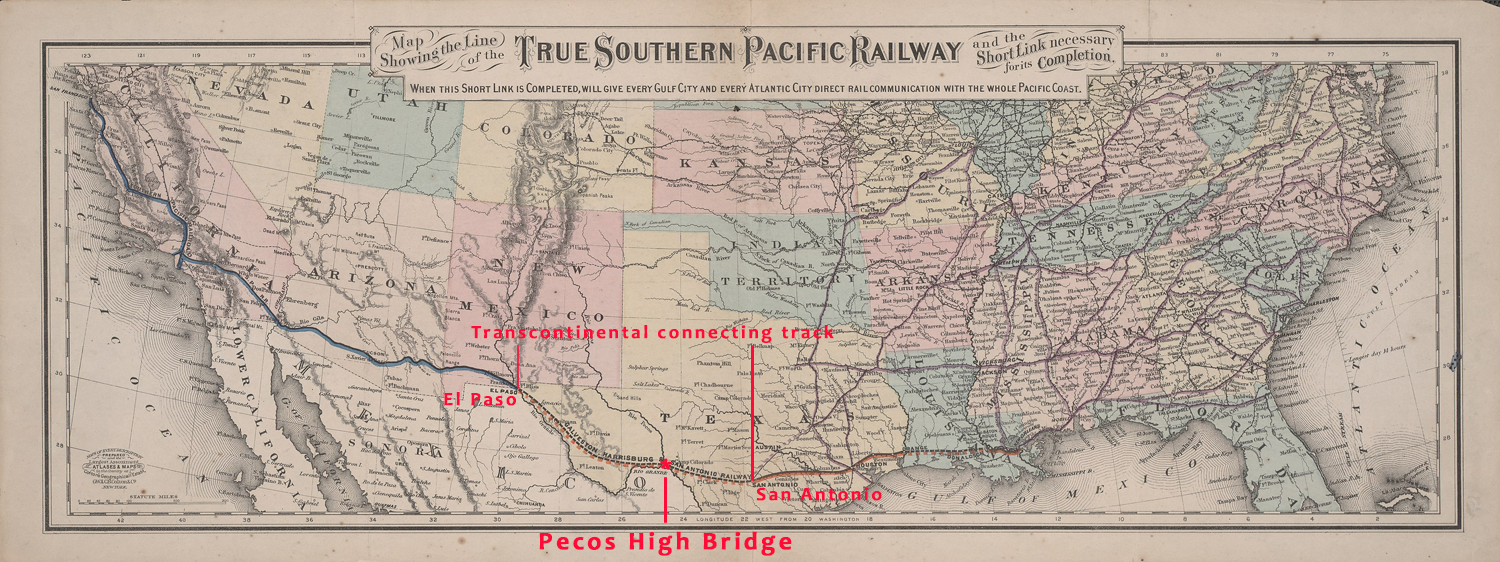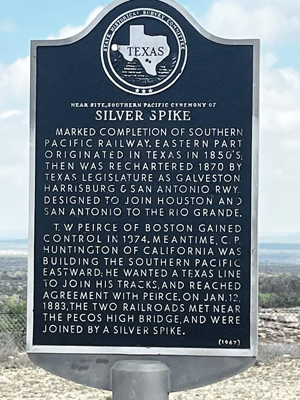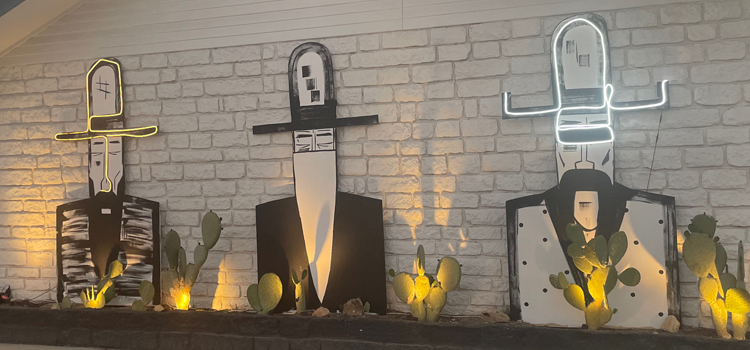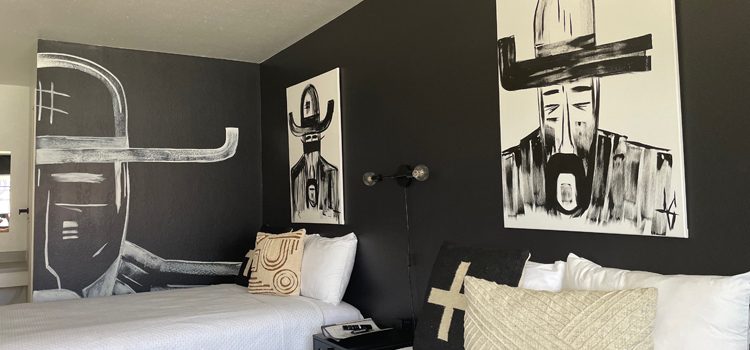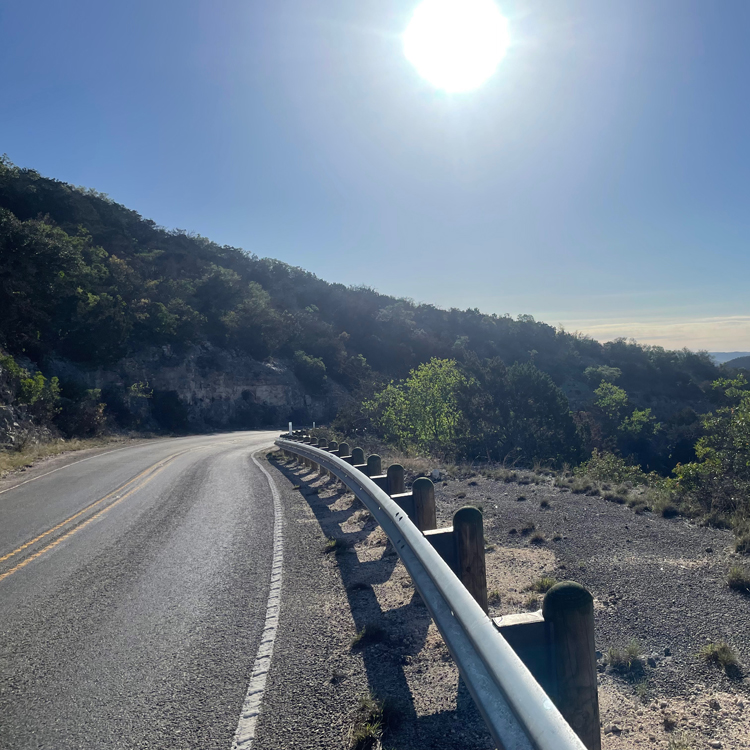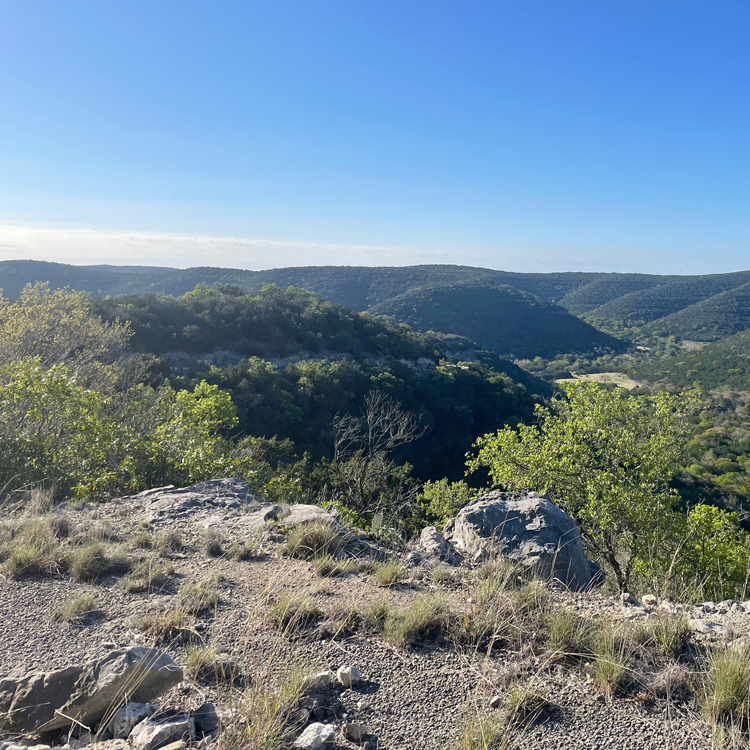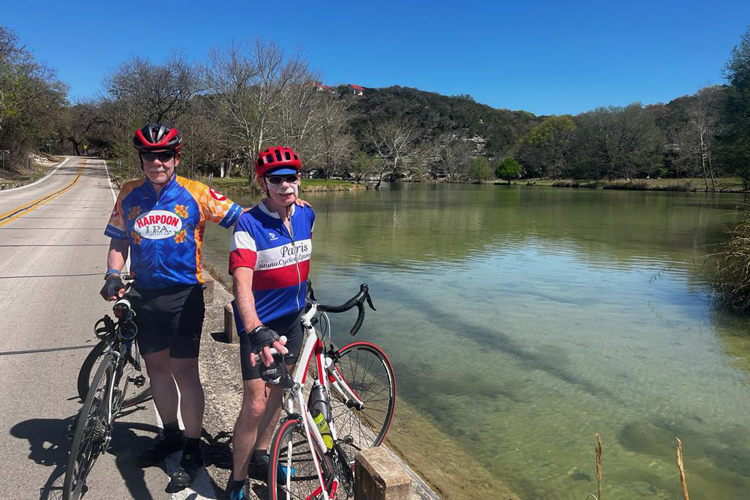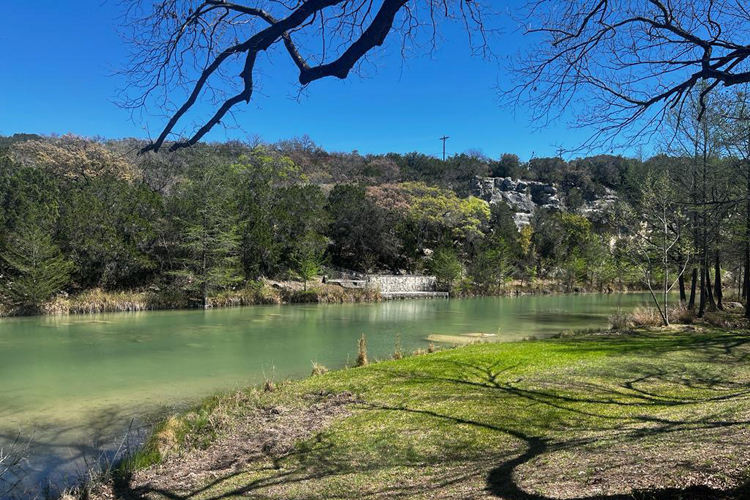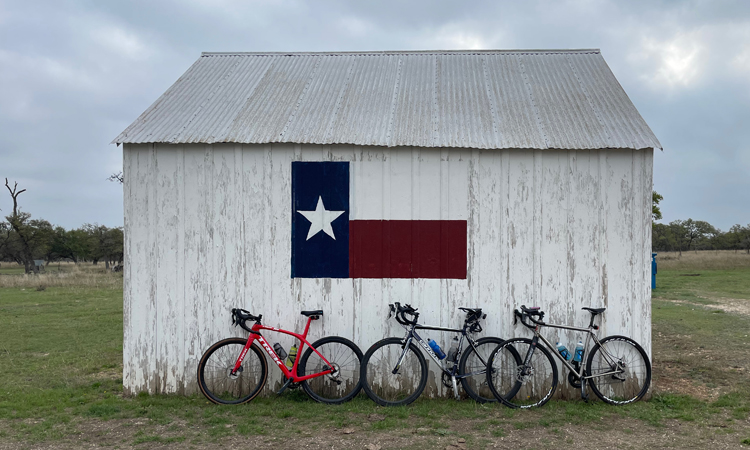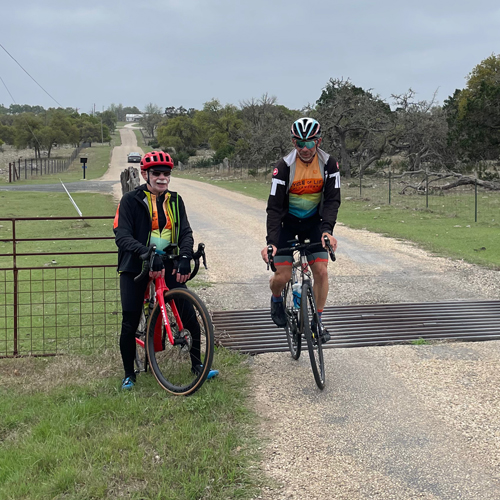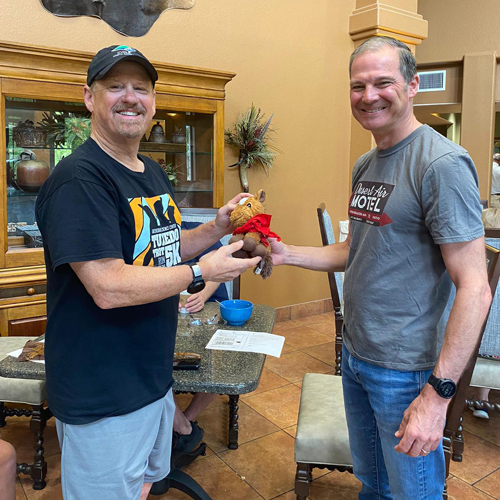
| Prologue | Wk 1: CA Hills to AZ Desert | Wk 2: High Desert to TX | Wk 3: TX Hill Country< | Wk 4: Flowers and trees to LA | Wk 5: Mississippi to the Gulf | Wk 6: Florida Panhandle to the Ocean | Epilogue |
Bicycling enthusiast from 1878: "You are traveling, not being traveled."
Week 3: Fort Davis TX to Fredericksburg TX. 427 Miles. 14,500ft elevation 1498 Total Miles
Three easy days sandwiched three not so easy ones. Day 4 was 120 miles, 3000 ft of climbing?
As with previous weeks, mostly we stayed in an array of (sometimes extremely) humble but clean motels and hotels, serving a constant reminder that hospitality comes down to the warmth of human connection, not the Egyptian cotton thread count.
We were warned the Texas Hill country would bring out the Harley’s and it did. Literally thousands of them typically in herds of one to three dozen. More poignantly, on the fourth day we made a left at a T junction that headed us into the wind (of course) but a right turn would have taken us into Uvalde.
The hill country truly rolls, creating the second-hardest climbing day: 4800ft in 80 miles. Four separate climbs with serious anaerobic work for 1-2.5 miles to each peak. Even the big dogs found it tough.
Food is amazing, we continue to support local business, sometimes as humble as homemade enchiladas from the Mexican innkeeper, sometimes as highfalutin' as stuffed grouse. Now we are into bbq country too, as well as, to my surprise this early, catfish.
Tuesday March 21 Fort Davis TX to Marathon TX Elevation: 4055ft
Temp: 48f - 73f Ascent: 1237ft Distance 54 Miles
Another couple of days without a single ride note in my book. They must indeed have been "rolling rest days." Although we were riding, it was only 54 miles, and that was not because there was a mountain to climb. It was because the next day was a big one.
Coming out of Fort Davis I saw the only Amtrak of the trip. It's eight or ten cars looked like a toy train compared to the hundreds of cars that make up the freight trains.
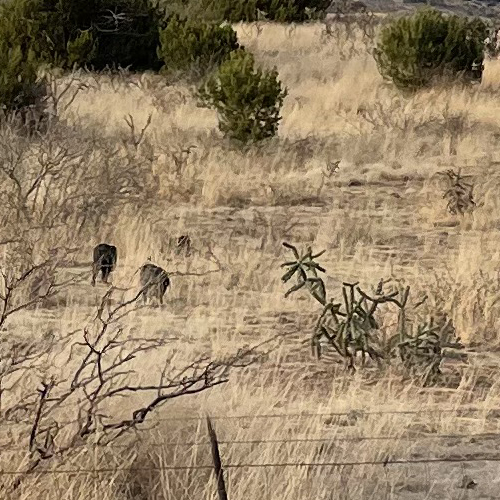
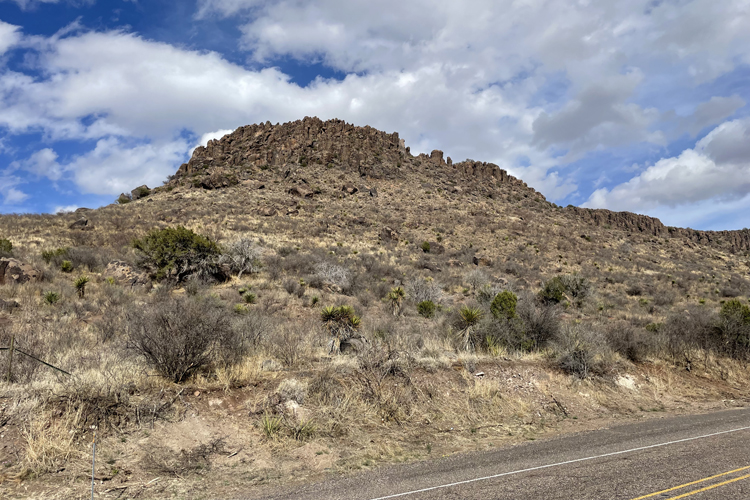
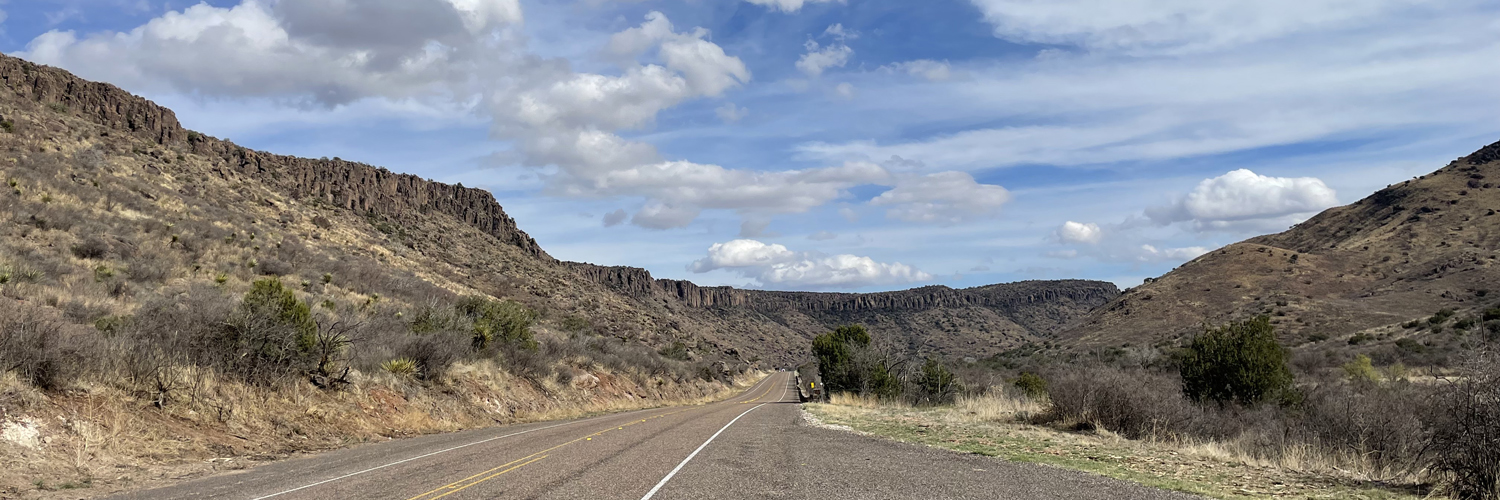

Steven channels Monty Python
|
L to R: Dave-the-Elder; Bobby; Dave-the-Younger; Doug; Betsy; RT; Craig; Bill; Kevin
|
One of the locals said something about us being in the largest county in the Union with the lowest density of people, which sounded like something that might be trusted, but definitely should be verified. If he meant Texas not "the Union" (which felt like the kind of mistake a Texan might make) then indeed he was correct: Brewster County is the largest county in Texas, and since that already makes it larger than Connecticut, we'll grant some license there I think. It is not even close to the least population, there are dozens of counties with fewer people, but again, with a 2020 Census population count of 9546 that is not a lot of people to spread across Connecticut, especially when Alpine and Marathon alone must account for a significant portion of them.
He was a chatty guy. I think he must've been talking to Bill, the master of questions, appropriate and otherwise. "The difference between the mid-west and the west is that in the mid-west they count cattle by heads per acre. In the west they count them by acres per head." Sure enough, as this week progressed and we lost several thousand feet from the high plains of Arizona and New Mexico as we headed towards the Texas hill country, the ranches gradually got closer together, and everything started greening up.
The 12 Gauge Restaurant at the Gage Hotel in downtown Marathon was arguably the finest dining of the whole ride. We barely scratched the surface of the place being seated in our own area near the front door, but different themed bars seemed to stretch deep into the interior, and when I looked the Hotel up I found there was even a completely separate brewery somewhere else on the site along with swimming pools, spas, banquet halls and on. But back to us. Our area was quintessential Texas, all cowhides and wrought iron, and ginormous buffalo heads on the walls.
What I ate says it all. Crispy Spicy Fried Quail with bleu cheese dressing, fermented Fresno hot sauce, pickled quail eggs and fresh celery, followed by Stuffed Quail with chorizo and fennel rice, black bean and bacon purée, green beans and roasted tomatoes, and chimichurri (a South American condiment made from cilantro, parsley, oregano, shallots, chile, garlic, vinegar, but the ingredients seem to vary widely). Even my cocktail was outstanding and imaginative: Early Check In, whose main ingredients were Marfa Spirit Co Gin (so as local as it gets) and Rosemary simple syrup. I had a shot of the gin on its own just to check it out and it was good, but not outstanding enough to go out of my way to track it down.
There was a lovely little oasis in the middle of the motel compound. Mexican adobe-style, with one end an open covered area with a fireplace built into the back wall. I was delighted to find that when we returned from dinner about a dozen people were sat around chatting and laughing. They had lit a fire in the grate. It was hard to tell if they were all together or were just a bunch of random fellow travellers, but so nice to see them engaged in that primal human activity—chewing the cud around a fire. No cell phones or music, just people enjoying each other's company.
The town is famous for its telescopes and viewing sessions in the clear, light-free desert air, but it was too cloudy to see much that night, though Dennis was up early enough to see them in the morning. I was happy to learn later that the boys also saw them back in Fort Davis long after I was safely tucked up in bed.
Wednesday March 22 Marathon TX to Sanderson TX Elevation: 2789ft
Temp: 54f - 76f Ascent: 673ft Distance 54 Miles
The other 54 mile rolling rest day. This time because indeed the next day was a doozie. So it was a fairly early finish, and for once I risked an extra couple miles to cruise into town to check out the Big Bend Tourist Office which I'd seen advertized on our way in. Sadly it was not a National Park Visitor Center, but I did have a nice long chat with the woman who was on duty. Some 80 miles from the park itself, Sanderson is nevertheless a major stopping off point for tourists headed there.
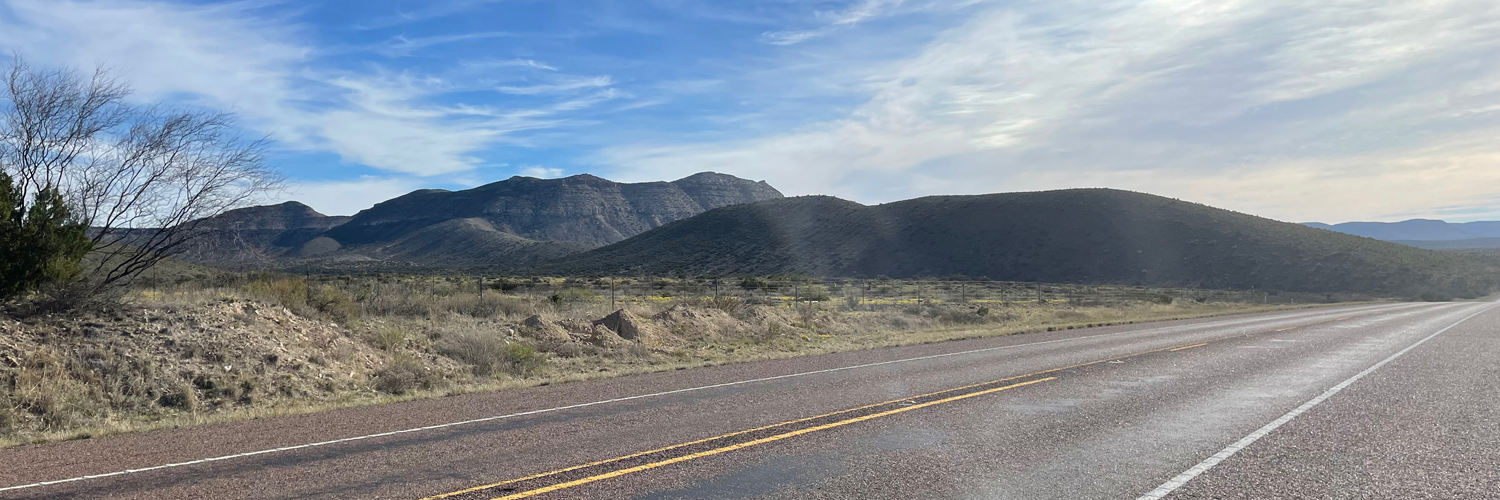
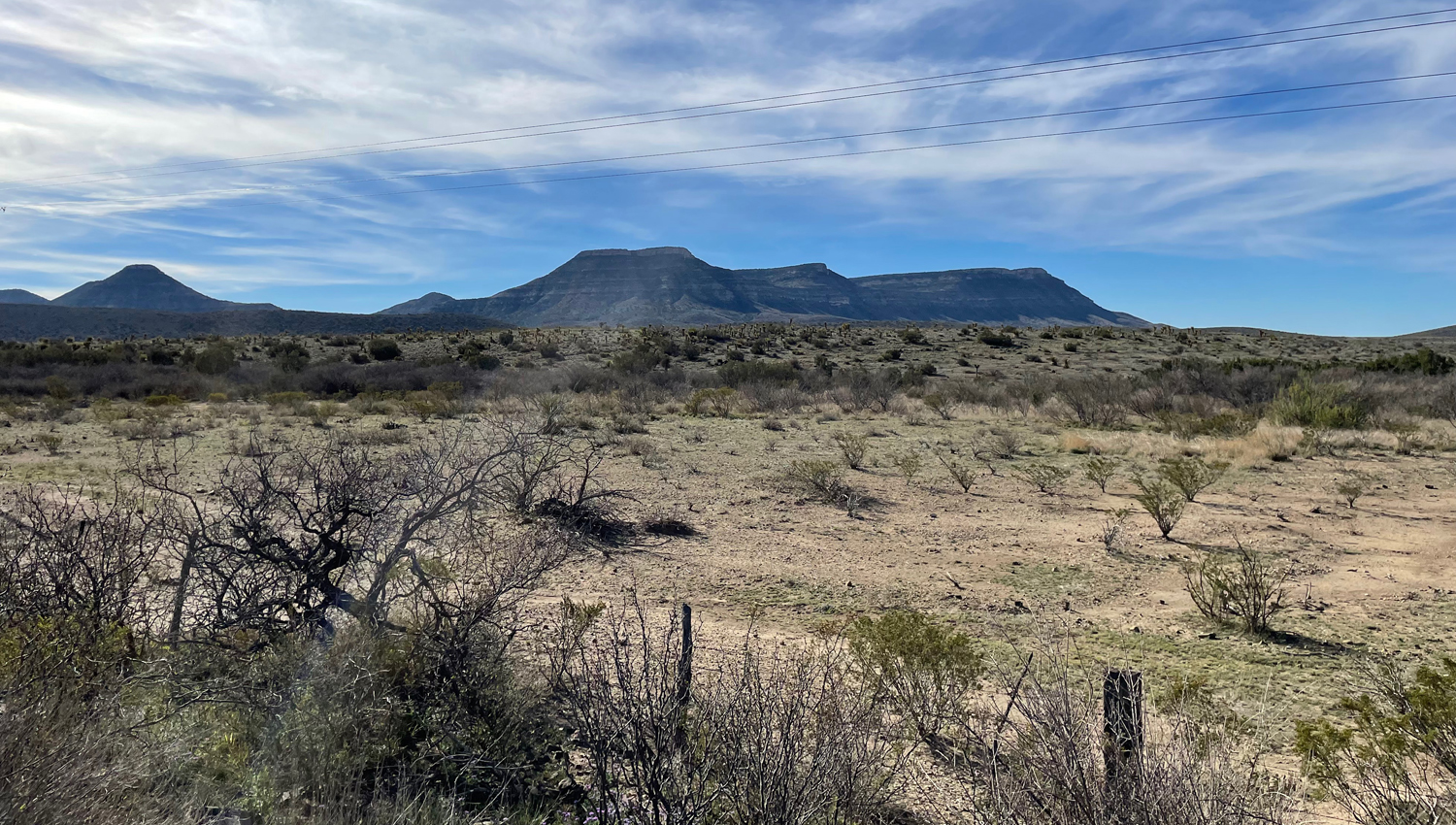
L to R: RT; Dave-the-Elder; Betsy; Steven
|
(Notice riders in the distance)
|
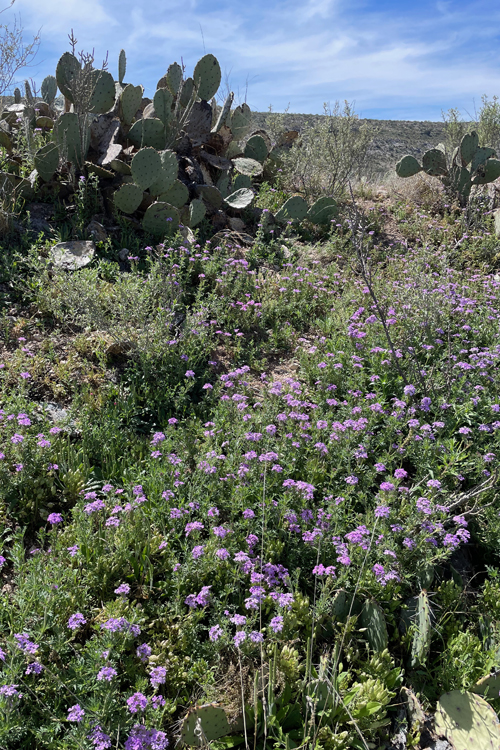
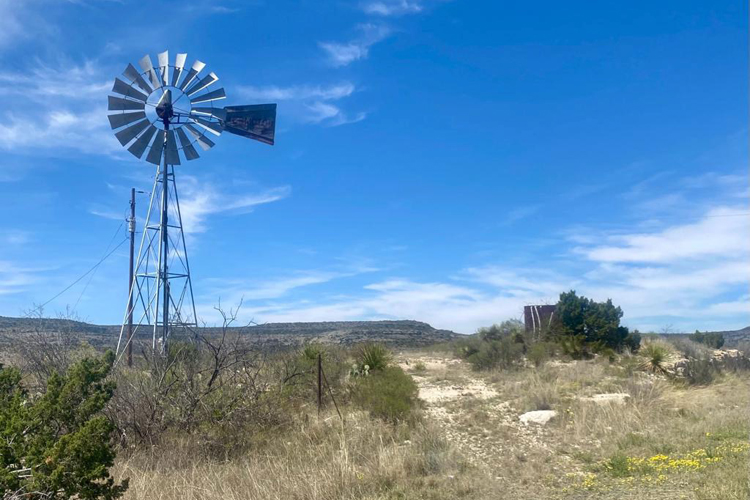
Everyone who'd signed the visitor book put Big Bend as their destination. I smugly wrote St Augustine FL as mine. Clearly I was not going to make it to Big Bend, but my new friend recommended "to Ferguson Motors" an old garage converted to an art gallery-cum-coffee shop just up the street. There was a palpable change of vibe as soon as I stepped through the door. If all of Texas gave off a MAGA vibe, suddenly I was in Greenwich Village, or Venice Beach. So I wandered through there for a few pleasant minutes, as always contemplating what I would buy if I had the money and space. And as always not much grabbed me by the wallet, but who cares, that's not really the point is it?
Downtown Sanderson
|
L to R: Dave-the-Elder; Bill; Dave-the-Younger; Kevin; Craig; RT; Steven; Betsy; Doug
|
The Ranch House on the other side of town was a shack in both appearance and attitude. The waitress was packing, which seemed perfect. It was the sort of situation I love watching in movies, but are far too intimidating in real life except when you and your friends outnumber the folks in the bar about 5:1, and especially when chief Dennis has been here before and clearly wanted to bring us back. No surprise however that no one suggested we rearrange the furniture into our usual banquet style. Instead we all meekly sat down three or four to a table and waited to do what we were told. It was amusing watching most of us trying to sneak a snapshot of the (tiny) gun on her hip, and I'm so happy that Doug (I think) managed to grab the one I've borrowed here. Apparently our packing friend softened a little when I had the temerity to ask "What is Texas toast?" She was obviously incredulous that someone would not know the answer to that, and the actual answer was so obvious that it sorta made the point: "It's like regular toast but bigger". Of course. It was a door stop. Finally she recommended the cobbler dessert, of which there were several. I don't normally do dessert but I normally make an exception for cobbler, and I had the peach and banana, an unusual but delicious combination. Nobody complained about the lack of ice cream. |
C'mon! What he plans to do with that spatula is at least ambiguous ...
|
... and this is surely the same derriere albeit a little worse for wear? (Note pistol in both pictures)
|
The trains are back, right alongside the road, and therefore right by the motel. The trains are few and far between, and it is not exactly "My Cousin Vinny" but the horn blasts are so close that the room comes with complementary ear plugs. Somewhere along the trip I learned that all trains use two long, one short, one long horn blast to announce their approach to crossings, but that experts can tell the individual "signatures" of their favorite engine persons.
|
Classic Bill
|
Thursday March 23 Sanderson TX to Del Rio TX Elevation: 984ft
Temp: 62f - 85f Ascent: 3281ft Distance 119 Miles
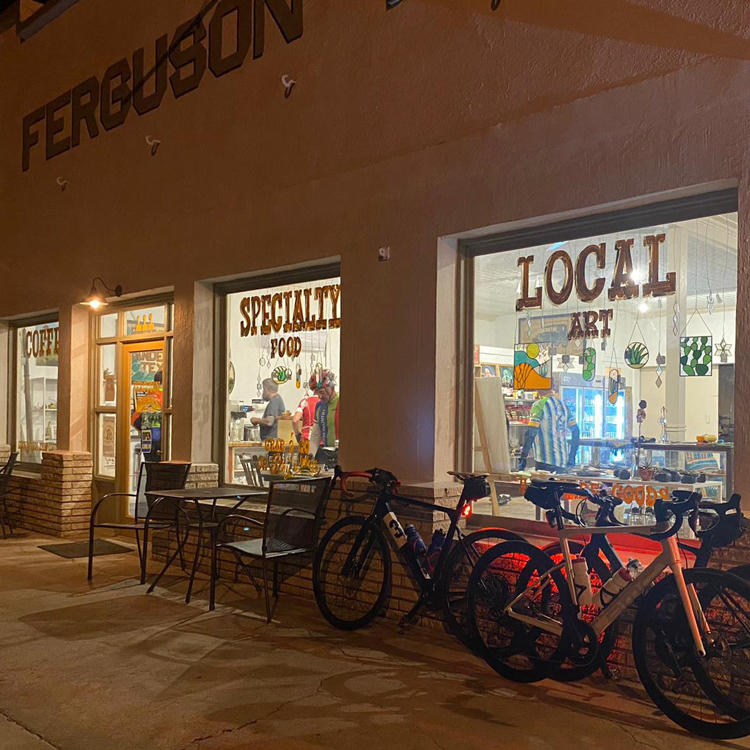
GPS: Turn left out of the motel. We turned left. GPS: Go 118 miles then turn left. But first breakfast, which I was delighted to discover was back at Ferguson Motors. So we did the first mile in the dark then leaned our bikes against the wall and went in for breakfast. The barista served us coffee and breakfast sandwiches and his three-year-old son in pajamas rode his tricycle in circles around us as we ate surrounded by the art work.
A day of two halves. We finally left the cafe at first light, around 7:30a under the densest lowest cloud cover we'd had all trip. It was spotting with rain for two or three hours, once or twice building to a level where drips fell from my helmet, but never getting to the point where I needed my rain jacket. At around 70F it was nice to have no additional layers on. Flowers were bursting out everywhere, purples, yellows, orange and white: poppies and shorter options.
The yellow and orange plants were obviously different species, but more often that not chose exactly the same spot to grow, so creating their own little bouquets everywhere. There were so many of them that we could smell them, and I think too we were smelling the sweet jasminey aroma of the (mimosa?) trees, which have also suddenly produced leaves, confirming my suspicion that things were greening up. In fact so green was it today that mowers were out trimming back the grass (and garbage). We crossed a picturesque canyon that I couldn't resist, despite promises not to stop on this long day. The two goats on one of the canyon walls made me do it.
That canyon turned out to be Eagle Nest Creek. A stone's throw from the Rio Grande. It was only as I prepared photos for this blog that I became aware of the amazing geography that was unfolding around us. The photo of Eagle Nest Creek was taken almost literally a stone's throw from the Rio Grande, and I 80 is being funneled into the narrowing gap between the Rio Grande and the Pecos River, making the Pecos High Bridge our only exit.
Of all days not to lose focus, as an obviously self-supported Southern Tier through bikers going west passed us, Bill peeled a U-turn across four lanes of traffic to chase after him. Dennis bellowed "Nooo" and Bill waved a paw in acknowledgement like Paddington Bear implying, well implying what? I got this? No you do not! I don't give a rat's ass? Perhaps more to the point. But what was obvious to everyone else was that the casual nod from the lead guy meant he was not interested in chatting. The thrilling revelation when Bill tracked him down that he was with his wife was guessed by the rest of the crew as we passed a woman with the same equipment 200 yards behind him.
At about the 60 mile mark we passed the turn for Langtry, named by Judge Roy Bean after his heart throb, the English actress Lily Langtry.
Judge Roy BeanI wasn't going to write up anything about Judge Roy Bean but he turns out to be such a despicable character I couldn't resist. Before heading to Texas in his thirties, he'd already survived two duels and a hanging. He robbed his brother's safe, attempted to run a firewood business by cutting down a neighbor's timber, tried to run a dairy business but was caught watering down the milk, worked as a butcher, rustling unbranded cattle from other area ranchers for his business. By the spring of 1882, he had established a small saloon near the Pecos River in a tent city he named Vinegaroon. Within 20 miles of the tent city were 8,000 railroad workers. The nearest court was 120 miles (190 km) away at Fort Stockton, and there were few means to stop illegal activity. A Texas Ranger requested that a local law jurisdiction be set up in Vinegaroon, and on August 2, 1882, Bean was appointed justice of the peace for the new Precinct. Bean then turned his tent saloon into a part-time courtroom and began calling himself the "Only Law West of the Pecos." As a judge, Bean relied on a single law book, the 1879 edition of the Revised Statutes of Texas, and when newer law books showed up he used them as kindling. Bean did not allow hung juries or appeals. Jurors, who were chosen from his best bar customers, were expected to buy a drink during every court recess. He was also known for his unusual rulings. Unusual is okay with me, if there is some sort of rough justice, or imaginative sentencing, but these examples show no such humanity:
All the sources I read were conspicuously silent on my first question: how did someone this despicable get the job in the first place? But maybe that is a clue right there? Faced with finding someone capable of single-handedly upholding any kind of law, with absolutely no backup within 100 miles, one can imagine you'd need to look for someone pretty determined, self-assured, and above all, fearless. If you were prepared to overlook his apparent obliviousness to right and wrong (and that's a big "if") I suspect he would have had few peers resume-wise. The American predilection for idolizing ruffians remains a mystery. |
|
Back to the ride. On over a beautiful dry canyon, Eagle Nest Creek (below), and finally (right) a much, much bigger canyon, with a scary multi-hundred foot drop into actual gen-u-ine water: the Pecos River everything west of which was the Judge's domain. Near here too is the site where the southern branch of the Transcontinental Railroad's east and west efforts finally met.
Below is another shot of the Pecos River looking south from the east bank. It might even be the T-Junction into the Rio Grande that you can just make out at the end.
|
The Pecos High Bridge, focus of several stories above and below
Then around the 70 mile mark things seemed to suddenly change. The sun came out, raising the perceived temperature about 10 degrees, the road became busier and wider, and the now habitual headwind picked up. For a mostly down hill day we spent a crazy amount of time grinding up one hill after another, the quiet was replaced by the roar of traffic, and the smell of flowers was replaced by the smell of rotting roadkill. |
|
To add insult to injury, at the 95 mile mark Dave-the-Elder's crankshaft came off leaving it swinging in the air, attached to his shoe by the pedal. I was mesmerized. It looked so strange I couldn't put all the pieces together. He had this thing dangling off his shoe and clanking along the ground. He was making no attempt to pedal. At the same time he seemed in a similar state to me: not knowing what was happening, and what to do next, how to come to a halt without falling over. It's just not natural to have neither foot attached to the bike. His day done, once he'd established that the sag wagon was turning around to collect him, we both agreed that I needed to keep moving and with great reluctance I left him standing there and set of to tackle the final 25 miles on my own. |
Map showing how close we were to the Rio Grande, and how trapped we were between it and the Pecos.
| Now that is what I call a wide load.
|
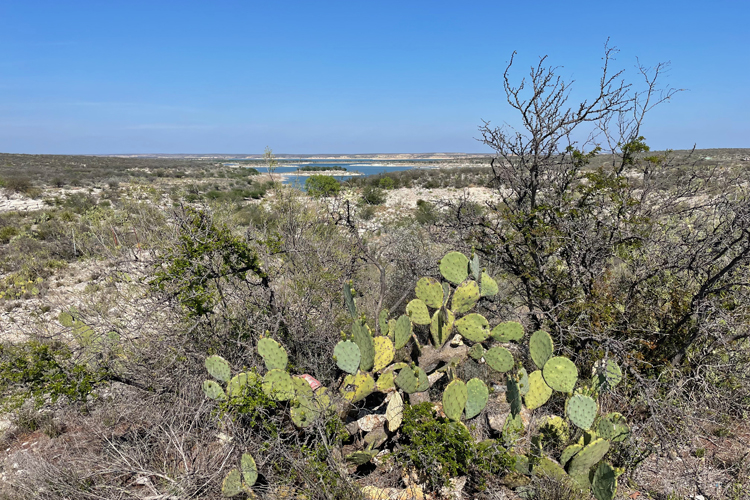
The Amistad Reservoir (part of another National Park I had to ride right by) was a lovely view and the largest body of water we'd seen since the Pacific. It was in view and along side for the best part of 10 miles before finally crossing it on the Governor's Landing Bridge a mercifully low-level affair that allowed one to enjoy the view without worrying about plummeting over the side.
My right big toe was barking loudly as I pulled in, which I would not bother to mention if it were not for the fact that Kevin complained of exactly the same thing. We put it down to "digital heat exhaustion."
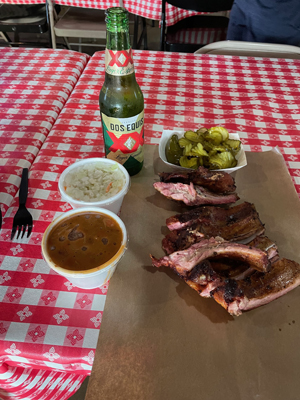
Rudy's Real Texas Bar-B-Q (and gas station) was as awesomely eccentric as it sounds. The three minute walk from the hotel was plenty in the heat and humidity. Inside it was a barn, with 40 ft long tables encouraging mass communal dining. On the way to the serving hatch at the back right corner, one of the tables was replaced by a shallow galvanized tank. Like frozen terracotta warriors, beer bottles were lined up rank and file and up to their necks in ice, so all you could see was the cap. So grab your beer, then pass by the cooler with sides such as cole slaw and ice cream then on to the cashier who took your meat choice (orderable in half-pound increments) and any hot side such as beans. Load everything onto your tray and find somewhere to sit. Not a problem at that time of night. Then I discovered that I'd missed an entire display of pickles and went back for pickled beets,jalapenos, and regular old pickles. Oh boy. Obviously I had baby-back ribs, but the brisket looked just as good.
Dennis was not a happy camper because for once he'd completely failed to herd the cats. At the appointed dinner hour, only half the crew were present. Bill had had mechanical problems and of course Dave-the-Elder was extremely anxious to see if he could resolve his crank issues already, and so Captain America had persuaded a not-all-that-local bike store to stay open while they raced over there. I think a couple of other folks were still scrambling to complete laundry / shower or something because I remember us straggling in as three separate groups. When I went back to the counter to buy a 32oz bucket to fill with lemonade (a wonderful find) I carefully avoided Dennis, and made sure to pay for the drink myself rather than even allow the impression that I was looking to add it to the communal tab. Sadly Dave and Bobby finally appeared without a solution for the crank.
The Southern Transcontinental Railroad
Okay, so I'm a railroad nerd. I'm crushed that I did not see it for myself, but close to the rest stop just east of the Peco High Bridge I missed the "Silver Spike" Historical marker. Fortunately I was once again saved by Bobby who knew I'd want to know. The Silver Spike marks the point at which the two ends of the Southern Transcontinental Railroad finally connected on Jan. 12, 1883. This was some 15 years after the Golden Spike (NP) at Promontory Summit, Utah Territory which marks the much more famous site where the Central Pacific Railroad from Sacramento and the Union Pacific Railroad from Omaha connected on May 10, 1869, at Promontory Summit, Utah Territory. Since I'd never heard of the Silver Spike, I sought out additional information from that font of truth and wisdom, the interweb. The first reference took me right to a page about the Historical Marker we had passed. The page does little more than describe the marker, which claims that "The Galveston, Harrisburg & San Antonio Rwy. was designed to join Houston and San Antonio to the Rio Grande." We had crossed the Rio Grande 400 miles west of here in El Paso. So why did it stop here on the Pecos? The second reference to a Silver Spike made things worse. It claimed that "In March 1881, a silver spike was driven into the railroad at Deming to mark completion of the second transcontinental railroad, which united the Santa Fe and Southern Pacific railroads." Deming is in Arizona and even further away from here. A third page, and a more thorough examination of the map resolved the mystery. This page also referred to the Deming site but like the Deming marker itself, made no reference to the completion of the second transcontinental railroad. Instead it celebrates the linking of the Southern Pacific railroad with the Atchison, Topeka and Santa Fe railroads. It was this new more extensive Southern Pacific, stretching to El Paso, that two years later was extended eastward to meet the Galveston, Harrisburg & San Antonio which was meanwhile being extended west. Galveston and Harrisburg would today be called Houston. Houston, San Antonio, and the Pecos High bridge are on a dead straight line east to west so that makes sense, and then zooming out on the map I finally figured out that the Pecos drains into the Rio Grande just a couple of miles down from the High Bridge. So this was the perfect spot to meet. |
Friday March 24 Del Rio TX to Camp Wood TX Elevation: 1457ft
Temp: 70f - 82f Ascent: 1978ft Distance 80 Miles
Grackles were arguing loudly in the trees outside the hotel as we prepared to set off. Passive-aggressive as usual Bill faffed around until his part in the 15 mins early for him and 15 mins late for everyone else was completely lost and he rolled out on his own schedule at 8a, leaving everyone else once again to suck up BFT: Bill F🤬ing Time. Overnight Dave-the-Elder had been fitted up with one of the spare bikes, and he and I rolled out about 10 minutes later. Even the inclines were a delight with no wind and smooth tarmac. Busy Rt 90 had a lot of 18-wheelers screaming by but the hard shoulder was also nice and wide. Mostly. We went passed an airforce base, where the traffic was reputed to be going, but I did not notice any difference as we left it behind. Mind you I didn't notice any planes either. There was a water stop on this busy shoulder, and Dave-the-Elder and I arrived simultaneously with the big dogs. Perfect. As usual I was more in need of a pee than anything else—they should be called P-Stops—but we refilled our bottles and returned to the fray.
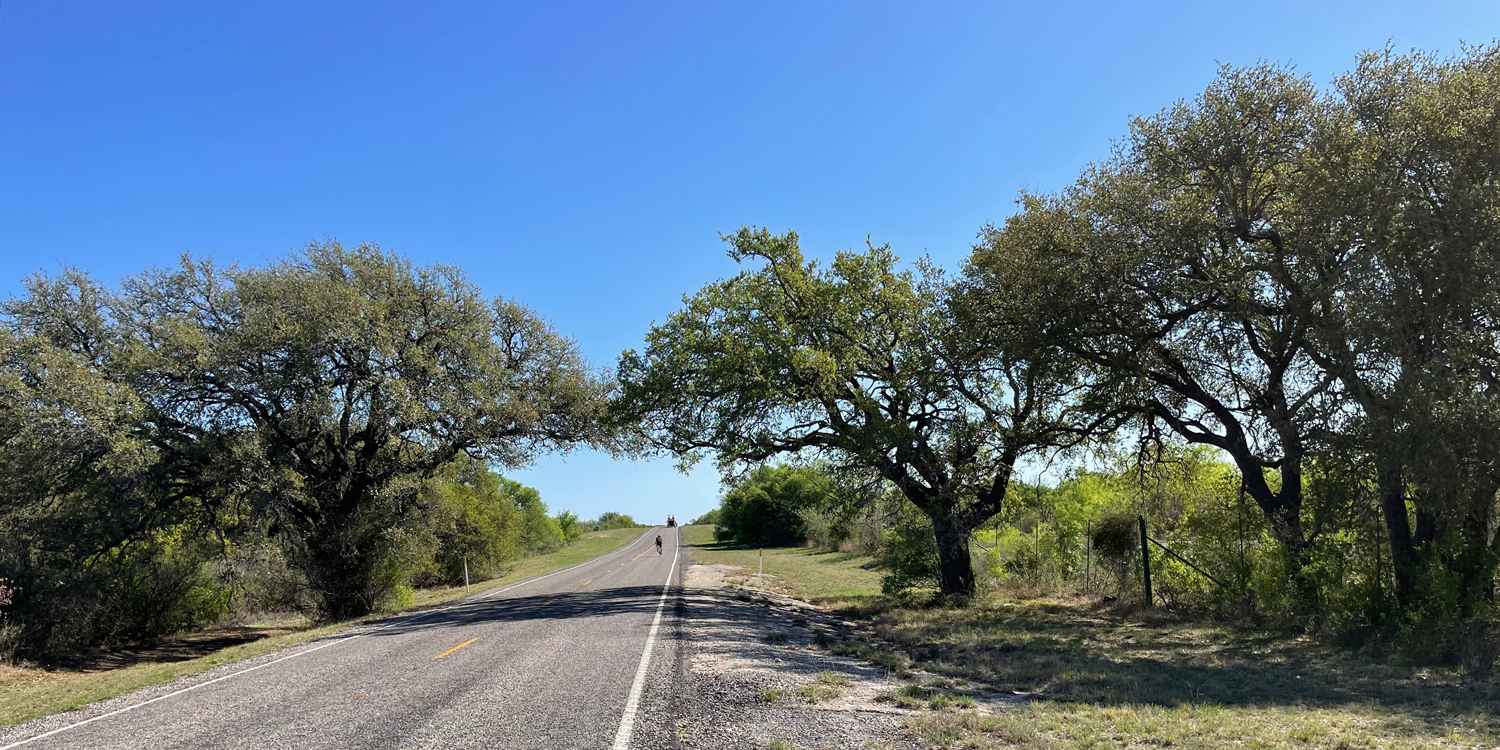
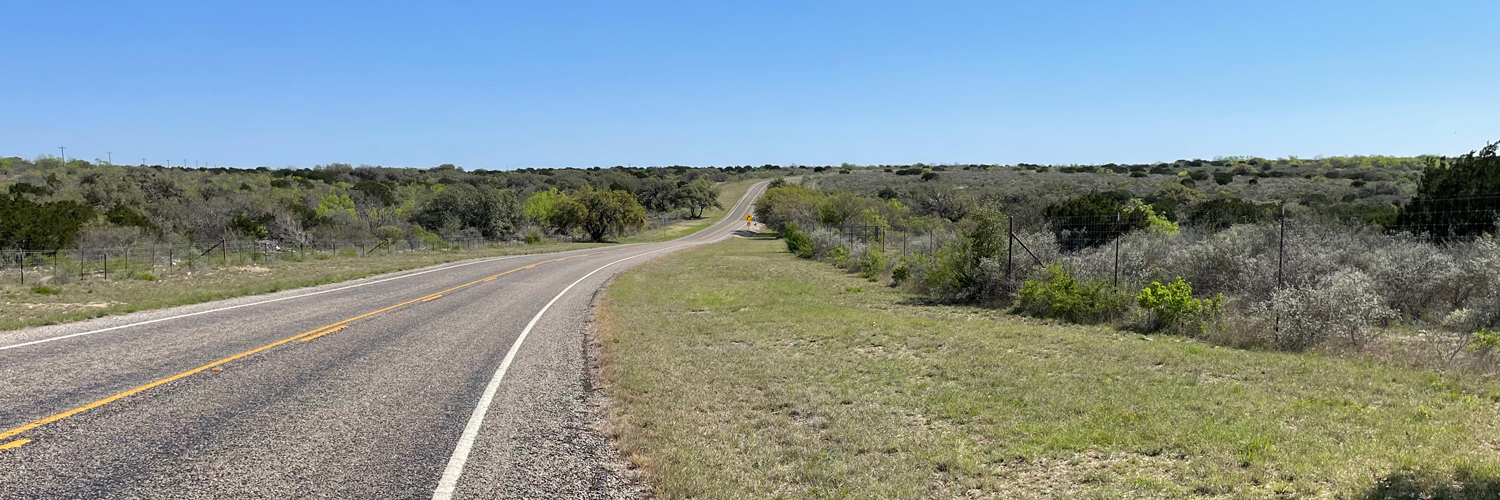
At about the 30 mile mark we turned onto much more rural MR674 and immediately lost the traffic. Just as immediately, Texas Hill Country was apparent. Trees, some of them big trees, not just on road- or creek-sides but sweeping back as far as the eye could see. Grass and flowers along the roadside. Ranch entrances much much closer together than we'd seen until now, reinforcing how much less land was needed to make a living. The rolling green hills and curving roads seemed a perfect setting for motorcycle riding. The only reason it was not ab-so-lutely perfect for bi-cycle riders is what we've now termed TWB Texas WashBoard which Betsy defined thus: "the horrid chip seal that coats the roads we’re traveling in South Texas. Chip seal is a thin film of heated asphalt liquid sprayed on the road surface, followed by the placement of small aggregate ('chips'), and is 20-25% cheaper than a regular asphalt road. It looks like packed down gravel but rides like a washboard, forcing bruxism with every wheel rotation."
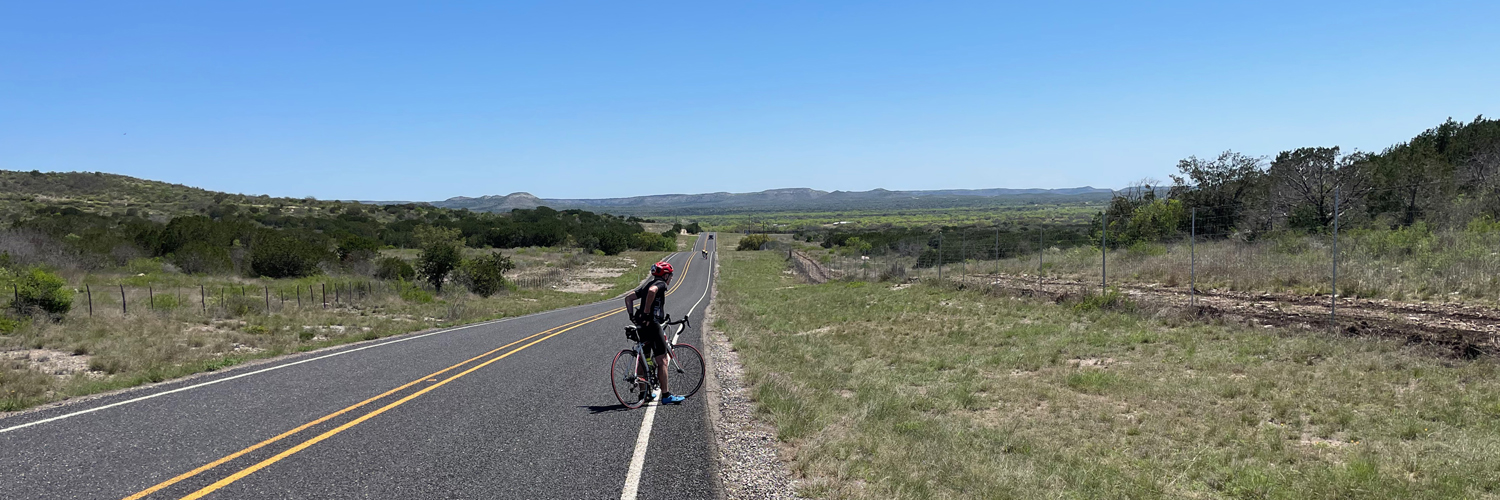
Right on schedule, as we made the left turn at a T-junction for the last 20 mile stretch to Camp Wood, the Harley's started to appear, and several herds of them went by on our way into town. We all noted somberly that a right turn would have taken us into the town of Uvalde (19 children and two adults were killed in a shooting at Robb Elementary School in Uvalde May 24, 2022 the deadliest shooting ever at a Texas public school). The headwind made its customary appearance, but it's heart was not in it, so despite several strong bursts, it was basically a non-issue, and we rolled into Camp Wood at around 3p.
We checked into The Cowboy Motel, a self-described "boutique inn" featuring rooms with western artwork by artist Laura Goodson, who had her own shop/studio right next door.
The Cowboy Motel
|
My room
|
For dinner, we piled into the van and drove down to the King's Texas Smokehouse which was small enough that we basically took up all the dine-in space. You grabbed your extras (beers, desserts, and ordered at the counter and then very efficiently the orders were brought to the table as they came off the grill. I had "The Beast" sliced brisket, grilled smoked sausage, bacon, grilled onion and jalapenos, lettuce, pickles, tomatoes, grilled in two slices of Texas toast. With fried okra and fried pickle chips. Hit my alley right on the nose.
Saturday March 25 Camp Wood TX to Ingram TX Elevation: 1732ft
Temp: 52f - 74f Ascent: 5410ft Distance 80 Miles
First a great breakfast buffet at Casa Falcon, the diner across the street. I had biscuit and gravy, and a large helping of a sort of tomato stew with jalapenos and peppers, plus what must have been boiled bacon—not crisp-like regular American bacon, but soft, stewed in its own juices, chewy bacon. And coffee poured directly into my travel mug. Probably the best breakfast yet.

|
|
|
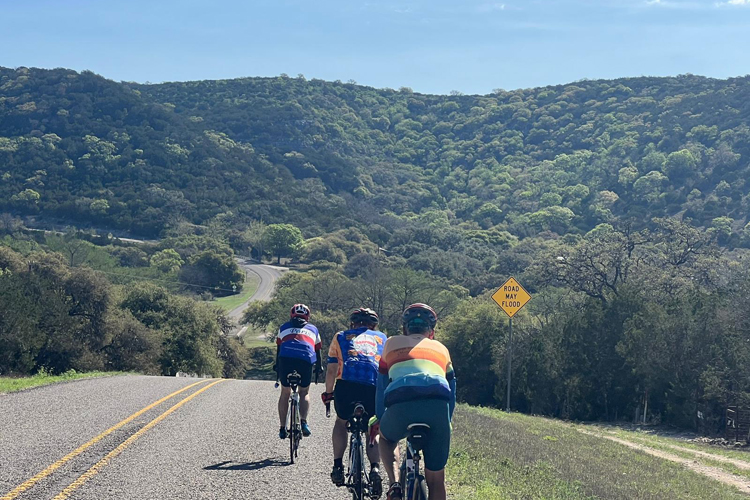
Texas Hill country today, at 5400ft the second greatest climbing after Day 1, and it was marvelous. Betsy described it as "endless folds of road that look like striped taffy, rising and falling as far as you can see in the distance, draping over the hills and limestone cliffs and cutting through groves of bright green trees." Exactly. And literally thousands of Harleys. 80 miles, four big climbs with serious anaerobic work for 1-2.5 miles to each peak, sweeping long downhills followed by the next grinding uphill.
The last climb was, in my not so humble opinion, the toughest of the whole route. Like the others today, not all that long but the gradient had me down to 3 mph, face on the handlebars grinding out one pedal stroke at a time and constantly wondering if I could keep it going all the way to the top.
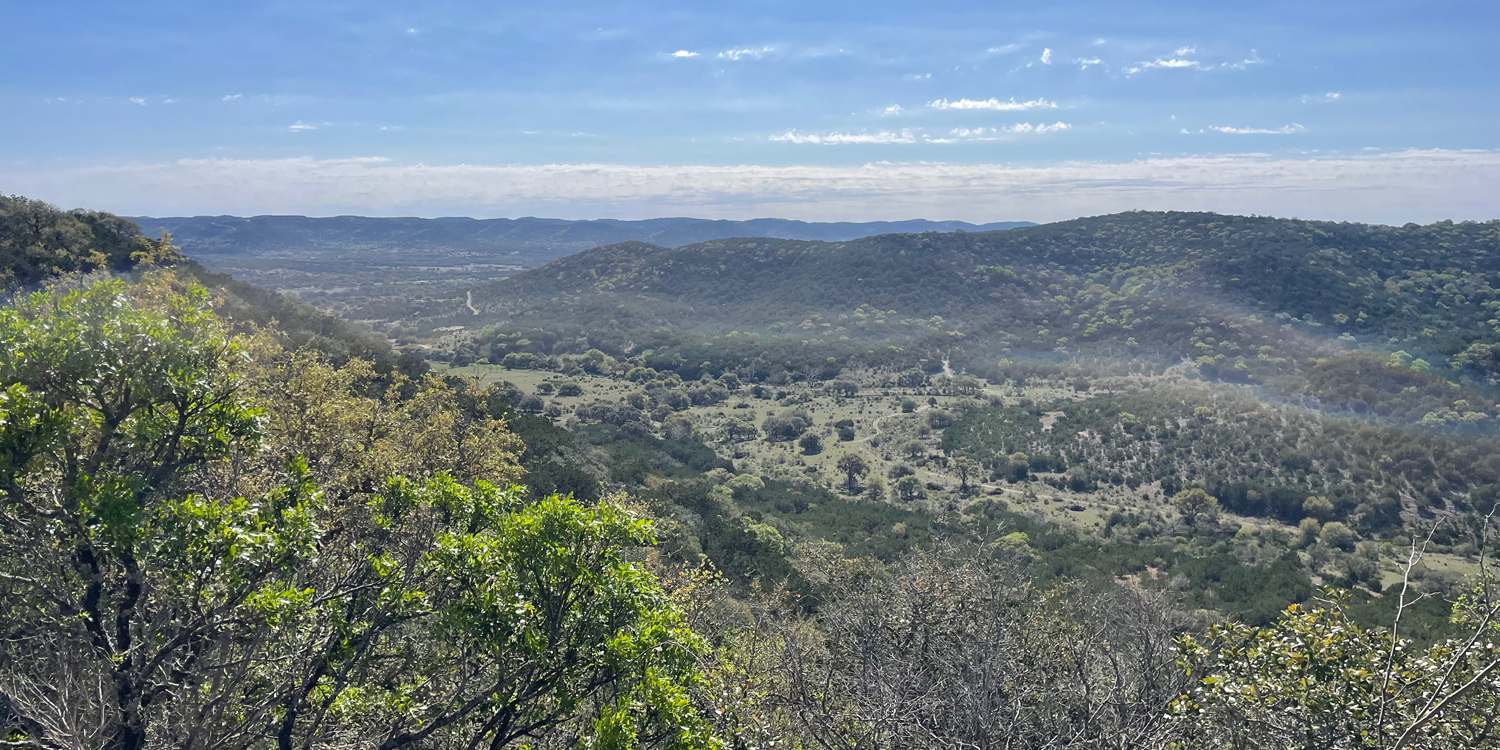
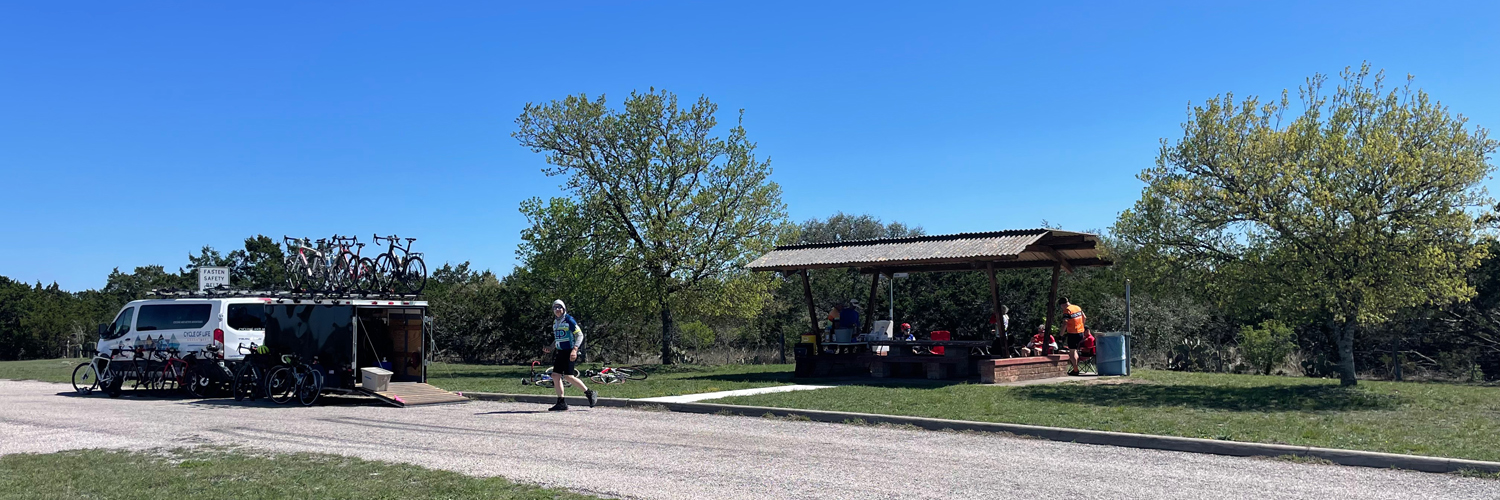
Lunch was at the summit of the last big hill. Bill wisely rode in the van to the lunch spot. Dave-the-Elder was absolutely over the moon to discover that we were in fact done. For some reason he thought we were only half way through the ascents. What a great feeling that discovery must have been. Another wonderful picnic of deli meats and cheeses with pickles, hummus and mustard all stuffed between two slices of brown bread, followed by M&Ms and Oreo cookies. Oh, and Dennis and Bobby had found me V8, hidden in the soda cooler. Heaven. Then a glorious afternoon with a much greater emphasis on the downhill.

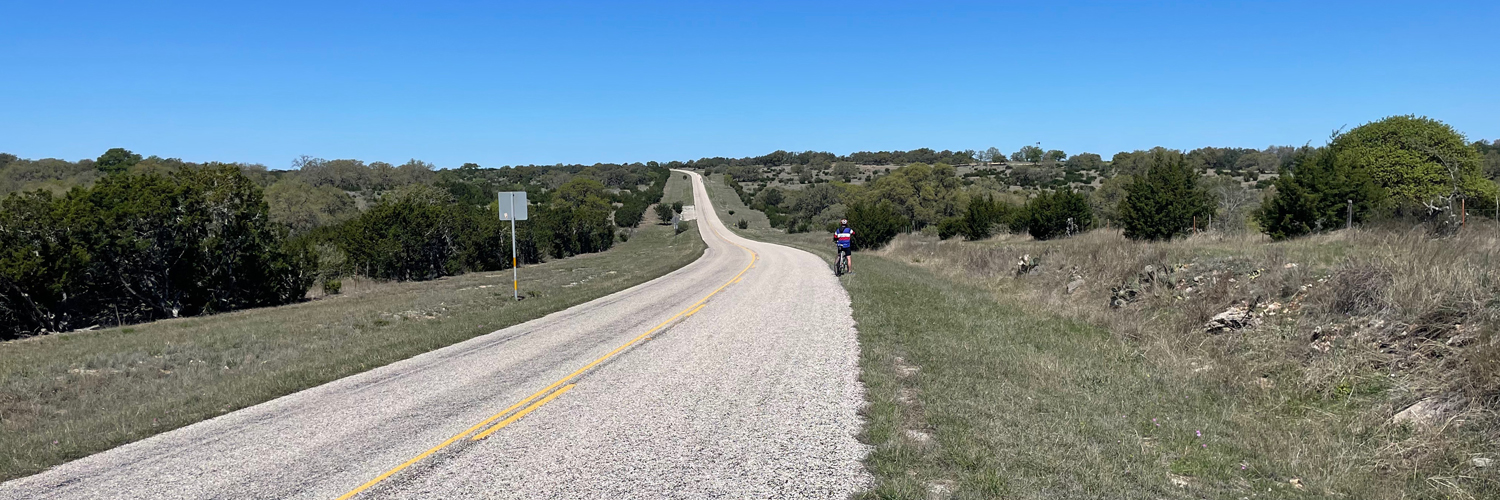
|
I swear I saw oryx through the trees at one point and then Dave saw something else equally exotic and incongruous. Finally we passed several grand stone entrances to the San Carlos Ranch giving me something to reference when I got home. So I did. "We offer the following facilities if you want a trip of pleasure, rest, relaxation or a hunting experience. We offer a wide variety of species of livestock for anyone’s hunting adventure. If you’re looking for a place to get away to rest and relax, San Carlos is the place." The mind boggles. You can rest and relax, or you can hunt the big game trapped by a fenced-in 10,000 acres. And yes, the game include oryx, water buffalo and bison. At about the 70 mile mark we came to the apparently famous "Boot fence" which I personally found fairly disturbing. Someone later pointed out that the fence is the unofficial "official" halfway mark between San Diego and St Augustine. I've just done the math, and if it is where I think it is, based on the aerial maps, we were 1525 miles in at this point so indeed, within only a handful of miles of half way. So I'll take it. A memorable half-way point. As to the meaning of the boots, there are a bunch of theories, but they mostly all boil down to respect. A tribute to a family member or hired hand who passes away, or a favorite horse that died or was sold, or even for the boots themselves now they have worn out. The last 10 miles were way more “domesticated” Two to five acre lots one after the other on both sides of the road. Although it was supposed to be "downhill all afternoon" and the fact that we weaved back and forth across the Guadalupe River implied the same, in fact every time we crossed the river there was a vicious little uphill to follow. Only a few hundred yards, but always bottom-gear-stand-on-the-pedals stuff that steadily grinds you down. As we finally hit town the river, or more accurately Lake New Ingram, fed by the river, was wide enough for waterskiers to come skimming by. The motel had a pool! Yay! It was f r e e z i n g! Yikes! No thanks. "Piffle" says Billy-Bob who tried to empty it with a bomb-dive. He manfully stayed in long enough to appear reasonably casual as he made his way back to the edge, then more sensibly retired to the beer cooler table. |
This macabre shot of the fence with all the boots which we passed late this week is the unofficial "official" halfway mark between San Diego and St Augustine. Sadly I only learned this by accident several days later.
|
|
|
The Lakehouse: famous for its catfish. Big-appetite Craig and Bill had the all-you-can-eat platter. It stumped Craig, but Bill (quite right, but here's the problem) had to order more of something, anything, for his pride to remain intact. He was clearly struggling but he came through like a champ. I'm sooo glad I was not goaded into that challenge. Did somebody say "cobbler"? I guess I'll be making room for dessert. Pecan cobbler? Pecan for me then obviously, just because I'd never had it before, and a la mode because finally there was ice cream. Wow. Best of show. Possibly even better than pecan pie. Pecan pie without the boring pastry.
Sunday March 26 Ingram TX to Fredericksburg TX Elevation: 1693ft
Temp: 48f - 74f Ascent: 1867ft Distance 40 Miles

When we set off in the morning, we assumed that we were already in an urban sprawl that would be our lot until we broke free again east of Austin. The motel was on a classic four lane highway that you appear to be able to find all over America, not withstanding how blessed we'd been at avoiding them until now: strip malls; gas stations; 2 to 4 storey apartment / office blocks; rinse and repeat. Imagine our delight then when within half a mile we took a left off the strip, and within another mile we were in open country.
Almost as incredibly, in fact to the point where Dave-the-Elder and I were being to wonder if our nav systems had let us down, we were less than a mile from the hotel before houses closed in on the road again. In between was just the most delightful English countryside. Pastures and meadows, cows and horses, live oaks and open vistas. At one point the road seemed to weave right through someone's front yard, with the main compound on the left, and the most-photographed object of the day, a white barn with the Texas flag painted on its side on the right. As each group came through, they all stopped to take its portrait.
|
|
We met a much more chatty west-bound through-biker, who stopped of his own accord at a water break and swapped stories about the route, and how great the wind was being. Grr. The last memorable sight was at Gillespie County Airport on the outskirts of Fredricksburg where an old DC 3 was parked so close to the perimeter fence that we couldn't get it all into the shot.
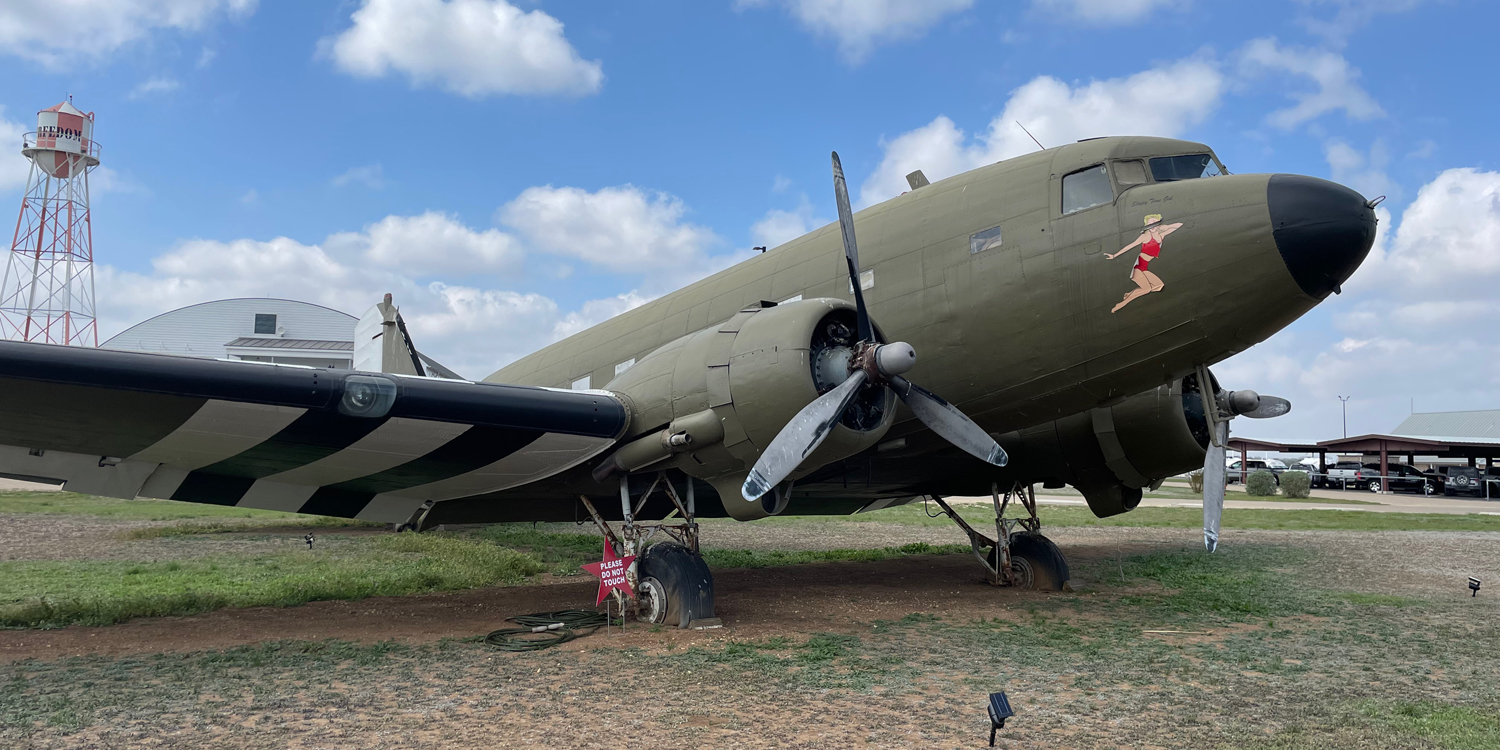
The Inn on Baron's Creek was definitely one of the nicer places we stayed at. Very hi-falutin' complete with day spa, functioning pool, and what an English brochure might describe as "lawns" down to, surprise surprise, Baron's Creek. Tables and chairs dotted the landscape. The classiness was only superceded by Betsy's husband Glen once again being on hand to pamper his wife for a day, and even more so by the arrival of Bobby's wife Lisa, who was a complete surprise! Even Dennis was a winner as his partner Elli was heading up another group who was using the same hotel for a clover-leaf tour around the area. Coincidence? Surely not. I can't believe it already, but it was Craig's last supper. The Auslander was a five minute walk to the main drag. I had Venison and Pork Cured Smoked Sausage but the hot potato salad was surprisingly disappointing, too oily, not nearly sharp enough. The weizenbeer from further up the street that I introduced Bobby to was excellent. One highlight from the meal was the waiter, who spoke cyclist. He confessed to his "n+1" problem (the ideal bike collection is n+1 bikes, where n is the current number of machines). The other was that by picking Connecticut to go all the way, I had accidently won the March Madness pool the big dogs had organized. It seemed churlish to pocket my winnings so I happily solved the problem by donating it to the beer kitty. |
For the last time, Craig hands off Scout into the capable and worthy hands of Dave-the-Younger.
|
Monday March 27 Fredericksburg TX
Day Off
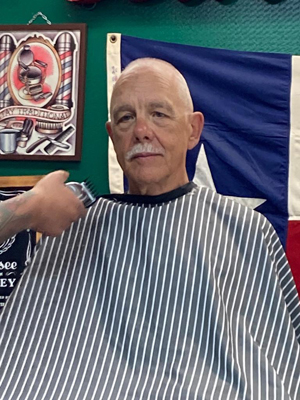
Base had called in and told me in no uncertain terms that today I was to find a barber and get my ears lowered. Fortunately several other boys seemed to have been provided with similar instructions. Kevin got an appointment despite front desk pessimism about anyone being open on a Monday. He warned the guy that several of us were interested and he, Dave-the-Younger and myself set off on foot to track down the Fredericksburg Barber Shop. It was a long walk in the heat, a mile and a half at least, and we passed another barber-that-shouldn't-have-been-open-but-was on the way, but our target was perfect, well worth the effort.
On the way back we tried to stop in at a bike-shop-that-was-supposed-to-be-open-but-wasn't and then were more successful at a liquor store in securing a much-needed donation to the happy hour cooler. With that and our morning slog-chore run was done. I persuaded the boys to carry both the beer and my night cap gin back to camp, while I headed straight on up the main drag to the main attraction of the day: the National Museum of the Pacific War.
Not that I'd heard of Fredericksberg, never mind its most famous attraction the National Museum of the Pacific War (NMPW), but apparently the NMPW is recognized today as "a world-class, cultural institution" providing "the nation's most comprehensive account of World War II in the Asiatic-Pacific theater." It seemed disrespectful not to make the time to visit.
National Museum of the Pacific WarWhy here? Fredericksburg is the hometown of Fleet Admiral Chester Nimitz, who oversaw the Allied war effort in the Pacific from the dark days after the attack on Pearl Harbor to the war’s end in September 1945. In fact, the museum’s original building was once the Nimitz Steamboat Hotel, an inn owned and operated by the admiral’s grandfather in the late 19th century. When approached about a museum in his honor, Admiral Nimitz instead insisted that such a museum should "honor all who served and supported the war effort in the Pacific". Curiously I could not find any descriptions to plagiarize about the excellent first fifty yards of the winding path through the main gallery, so I'm forced to use my own words and I'm no historian so take this with a liberal dose of salt. The path provides an excellent background and history of the events leading up to Pearl Harbor. That background stretched back nearly a century to the mid-late-19th century (think "Shogun") when Japan's Meiji rulers began the process of transforming Japan from a feudal society to one with equality with the west, and with it the flip from isolation to expansionism. The agreements reached between the Western powers and China following the 19th century Opium Wars came to be known as the “unequal treaties” because in practice they gave foreigners privileged status and extracted concessions from the Chinese. Although the unequal treaties and the use of the most-favored-nation clause were effective in creating and maintaining open trade with China, both were also important factors in building animosity and resentment toward Western imperialism. To cut a complex story extremely short, the subsequent jostling for power between Japan, Korea, China and Russia led to the Sino-Japanese War, the Russo-Japanese War, Japan's expansionism policies in general, and its World War I China policy in particular, which left behind a legacy of ill feeling and distrust, both in China and in the West. At the end of World War I, the victorious powers handed the Japanese a mandate over the former German islands north of the equator, one of the most important strategic areas in the Pacific. Japan's expansionism continued. Twelve years later the Japanese began carving out sections of China, starting with Manchuria in 1931. On the eve of WW2, Japan seized control of Indo-China from defenseless France and reduced Thailand (Siam) to the status of a puppet. By a combination of bluff and bloodshed Japan’s warlords, in less than half a century, had increased their holdings from under 150,000 square miles to more than 1 million. Fast forward to Sunday, December 7, 1941 and it feels like the only thing that should have been a surprise was when and where an attack would come, but come it would. The rooms then follow the war and its impacts west across the Pacific, from Pearl Harbor to the Doolittle Raid and Midway, Guadalcanal to Tarawa, Iwo Jima and Okinawa. Multimedia tabletops explained the time lines, impacts, and lessons learned from each of the conflicts. Artifacts from the war—tanks, planes, weapons, helmets, and uniforms of those who served—provided a visceral humanizing of the facts being laid out on the table tops. It was expert story-telling, how leadership, perseverance and heroism across the immense distances of the Pacific theater ultimately led to victory for the US.
|
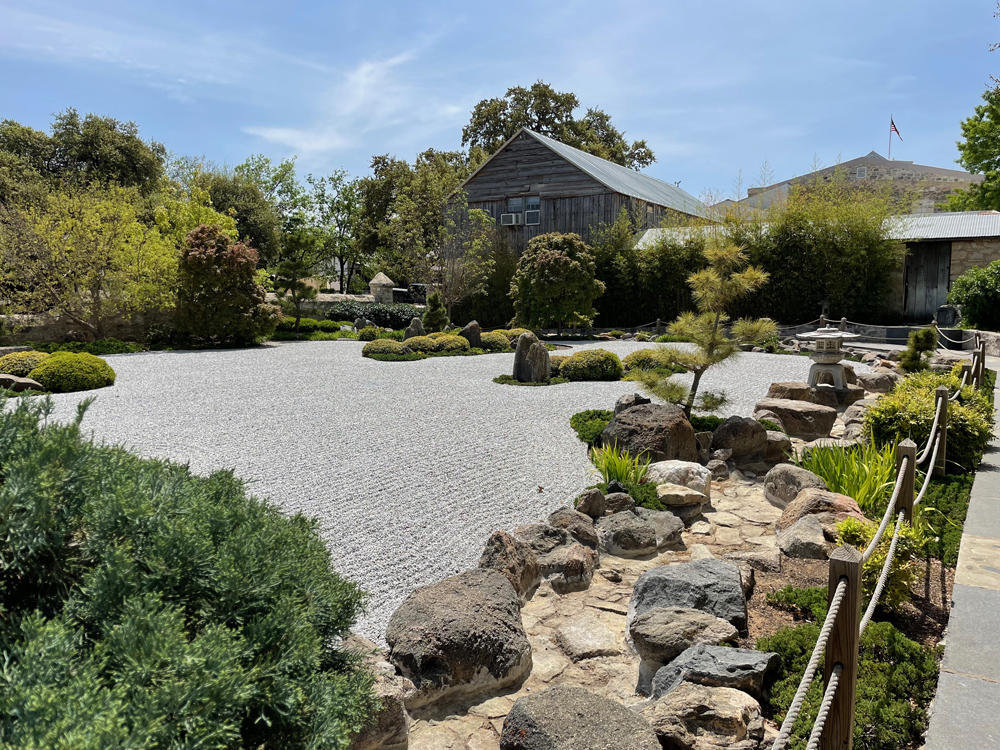
The NMWP Exit door lead through the Plaza of the Presidents (featuring ten monuments honoring presidents who served during World War II) to the Japanese Garden of Peace, gifted the museum by the Japanese government on May 8, 1976, the 130th anniversary of the founding of Fredericksburg. I love Zen Gardens, finding them, yes, peaceful, calming, but also extremely powerful, even for a fairly non-spiritual chump such as myself. They are to be experienced rather than simply visited. This one was no exception, but perhaps not surprisingly it couldn't hold a candle to those I'd experienced in Kyoto and Tokyo. A lovely peaceful way to end the visit nevertheless.
I would love to have visited the last big exhibition, The Pacific Combat Zone, but sadly and curiously, it was not open on Sundays. It is a re-creation of a Pacific island battlefield, featuring the Carrier Aviation Exhibit and the PT Boat Exhibit, a scale map of the Asiatic-Pacific Theater, the William P. Clements, Jr. Amphitheater and the Living History Battlefield. Definitely sounds worth coming back for.
I sought out the gin at the Elk Store distillery on Main Street. But they only had Old Tom. I said that was an odd choice, but to my amazement he said they'd stopped making the London Dry because it did not sell! WTF? (World-wide, London Gin outsells the other four types combined 10 to 1. If you've ever tried gin it was a London Dry style even if it called itself Bombay Sapphire. I see they are now selling London Dry on their website, so perhaps the bar tender was as suspect as I suspected. Still he had the last laugh, charging me $25 for a taste of the Old Tom and a shot of his Pecan Pie Moonshine. Yowser, I'm glad I hadn't planned to spend the afternoon there.
The (lovely) stone buildings and their small shop windows were gloomy enough that I kept thinking they were closed (it being Monday remember). But they were not: push the door open and there is life inside. An incongruous sign (to my northern eyes) on one of the doors provided a clue: "Please close the door to keep the cold in".
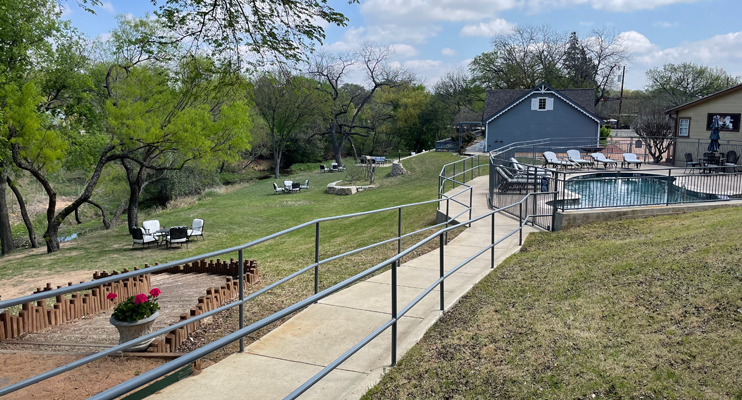
In yet another above-and-beyond gesture, despite the fact that rest days were supposed to be rest days for them too, and as such we were explicitly expected to fend for ourselves, Dennis and Elli hosted hors d'oeuvres "on the lawns" at the hotel, and invited their combined crews to join them. Elli's crew were of course very nice people, and I had a great chat with a couple of them, but there was no denying that they were completely different from the Southern Tier crew. It's hard to explain this in ways that do not sound critical or demeaning, which I have absolutely no intention of conveying, because it is completely untrue. But they were different. Perhaps it was a window into how even my friends see me: there's something a bit lunatic about someone who would do this, that others might admire, be amused by, respect, or destain, but no way on earth would they sign up for a trip such as this. "Are you nuts?" It made me more than a little proud to be tarred with the same brush as the rest of the crew, who let's face it really are lunatics. Wonderful, affable, supportive lunatics perhaps, but lunatics nevertheless. And I'm proud to say that my friends think I'm a bit of a lunatic too.
Finally, randomly (it's been bugging me this whole time), but three months into writing this blog, and five since starting out, I've suddenly remembered who Bill reminded me of: Ignatius J. Reilly, the mad genius hero of A Confederacy of Dunces, a book I read as a young man but which I never forgot and which is now regarded as a modern American classic. Anyway Ignatius/Bill arrived fashionably late to join (I think) Dave-the-Elder, Doug, Kevin and I for supper at Pasta Bella back in the town center. He perched on the end of the table and by making an instant order the moment the waiter arrived, managed to get served only a couple of minutes after the rest of us. I had #3 Sautéed diced chicken, sundried tomatoes, mushrooms, garlic, and spinach sautéed with olive oil and tossed with linguine. Yum.
It was a lovely evening, and Dave wanted to stop off at the local superstore so after supper he and I took a longer stroll than the others, in that general direction. Life was bursting out on the streets everywhere we went, from quiet cocktail tables outside what otherwise looked like a regular house, to a folk band playing to diners at an outdoor restaurant, to several dozen kids of all ages shooting hoops on three basketball courts. It was like being in an idealistic movie shot of the perfect American suburb, except nobody was directing. Perhaps it really was the perfect American suburb.
